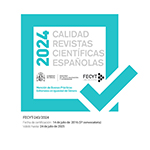A prison without bars? Thinking critically about social intervention in a shelter for imprisoned women
Abstract
The purpose of this article is to reflect on how women deprived of liberty experience their release from ordinary penitentiary centers, specifically, I analyze the ways in which the shelter combines functions as a control device and accompaniment in their permits and releases. In this context, the borders between the inside and the outside of the prison are diluted and it is increasingly important to explore the continuities-discontinuities of punishment. This leads me to reflect, from the ethnographic methodology, on how, once they leave, they experience other types of confinement through the extension of control beyond the prison. Women's experiences of deprivation of liberty are marked by different interwoven layers of social control, apart from the prison system itself. In this context, the shelter allows me to examine how this control continues to be present in lives in semi-freedom and, on occasions, in freedom. A field work carried out between 2017 and 2021 in the Autonomous Community of Andalusia, in an ordinary penitentiary center and a mixed social integration center, in a shelter resource for women in the second and third degree and in an association that intervenes in prison and accompanies processes abroad.
Downloads
Article download
License
In order to support the global exchange of knowledge, the journal Cuadernos de Trabajo Social is allowing unrestricted access to its content as from its publication in this electronic edition, and as such it is an open-access journal. The originals published in this journal are the property of the Complutense University of Madrid and any reproduction thereof in full or in part must cite the source. All content is distributed under a Creative Commons Attribution 4.0 use and distribution licence (CC BY 4.0). This circumstance must be expressly stated in these terms where necessary. You can view the summary and the complete legal text of the licence.









